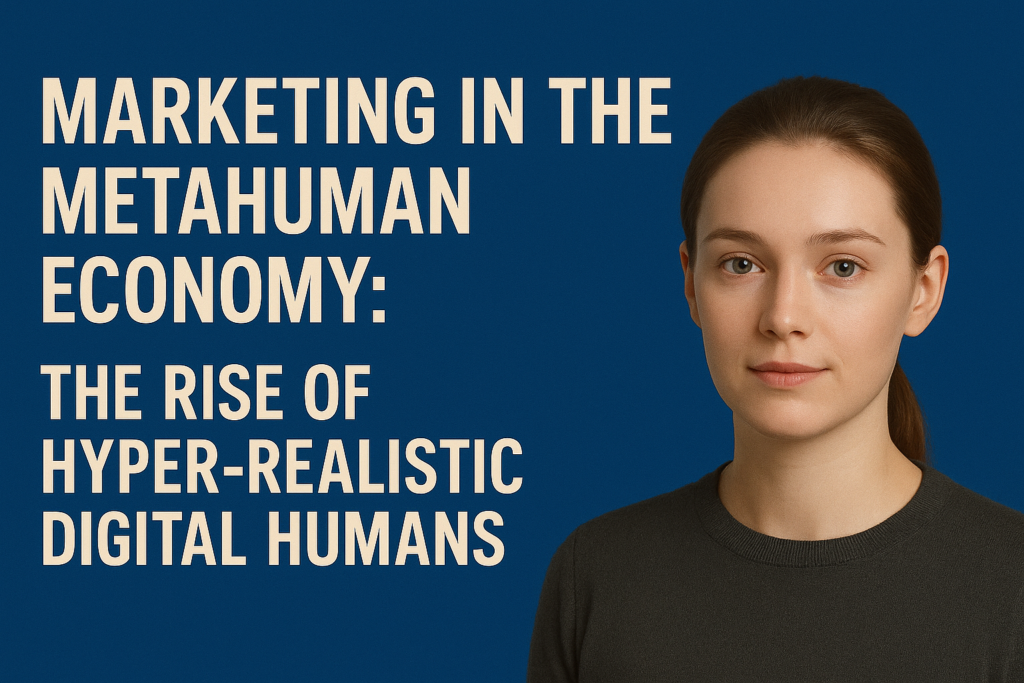The Rise of Metahumans: The Future of Influencer Marketing Is Digital
Welcome to the future of marketing—where influencers are not born, but designed. As technology evolves, so do the ways brands connect with their audiences. Enter the metahuman economy, a new era driven by hyper-realistic digital humans that are redefining influencer marketing.
But what exactly are metahumans, and how are they changing the game for businesses, marketers, and consumers alike?
What Is a Metahuman?
A metahuman is a digitally created person who looks, moves, and speaks just like a real human. Created using advanced 3D modeling, motion capture, and AI technology, these virtual beings can express emotions, engage with fans, and represent brands online—without ever aging, sleeping, or making PR mistakes.
Tools like Unreal Engine’s Metahuman Creator have made it easier than ever to develop lifelike avatars that blur the line between fiction and reality.
Why Are Brands Turning to Metahumans?
In the age of influencer fatigue, where audiences are overwhelmed by repetitive content and inauthentic posts, digital humans offer something new and exciting.
Here are a few reasons why brands are investing in metahuman influencers:
1. Total Creative Control
Brands can fully script what a metahuman says, does, and wears. This eliminates the risk of controversial behavior or inconsistent branding that real influencers sometimes bring.
2. 24/7 Availability
Metahumans don’t sleep. They can post content, appear in campaigns, and respond to comments in real time, across multiple platforms and time zones.
3. Cost-Effective in the Long Run
While the upfront cost of creating a metahuman may be high, they don’t require travel, hotels, or ongoing sponsorship deals.
4. Highly Scalable
One metahuman can be rendered in multiple styles, languages, and formats—perfect for global marketing campaigns.
Real Examples of Metahuman Marketing
Several digital influencers have already made headlines:
- Lil Miquela – With over 2.5 million followers on Instagram, this virtual fashion influencer has worked with brands like Prada and Calvin Klein.
- Shudu Gram – Dubbed the “world’s first digital supermodel,” Shudu has partnered with Fenty Beauty and Samsung.
- Imma – A pink-haired Japanese metahuman, Imma has appeared in campaigns for IKEA and Puma.
These virtual influencers have proven that digital humans can drive real engagement and conversions, especially with Gen Z and Gen Alpha audiences who are already immersed in virtual culture.
Metahuman Influencers vs. Real Influencers
| Feature | Metahuman Influencers | Real Influencers |
| Human Touch | Artificially simulated | Genuine emotion |
| Brand Control | 100% brand-owned | Shared control |
| Risk Factor | Low (no scandals) | Higher (reputation issues) |
| Cost Over Time | Lower | Higher |
| Audience Trust | Still developing | Stronger, but declining in some niches |
While real influencers still offer authenticity and human connection, metahumans provide predictability, control, and futuristic appeal. The best results may come from hybrid strategies that combine both.
How to Use Metahumans in Your Marketing Strategy
Ready to explore metahuman marketing for your business? Here’s how to start:
1. Define Your Digital Persona
Decide what your metahuman should look like, sound like, and stand for. Align this persona with your brand values and target audience.
2. Choose the Right Platforms
Metahumans thrive on visual and interactive platforms like Instagram, TikTok, YouTube, and even virtual worlds like Decentraland or Roblox.
3. Create Engaging Storylines
Treat your metahuman like a real influencer. Give them a backstory, personal goals, opinions, and hobbies. This adds depth and builds loyalty with followers.
4. Collaborate with Real Influencers
Pair your metahuman with a real celebrity or influencer for a powerful co-branded campaign. The contrast sparks curiosity and viral potential.

Challenges to Watch Out For
Despite the excitement, metahuman marketing also comes with challenges:
- Authenticity concerns – Some audiences may find digital influencers “creepy” or fake.
- Ethical questions – What happens when digital humans become indistinguishable from real ones?
- Legal risks – Who owns the rights to a metahuman’s identity and content?
These issues will need clear policies as the metahuman economy continues to grow.
Conclusion: The Future Is (Virtually) Human
The rise of metahuman influencers is more than a trend—it’s a shift in how brands think about identity, storytelling, and customer engagement. Whether you’re a startup or a global brand, now is the time to explore digital human marketing before your competitors do.
Stay ahead. Go virtual. Market in the metahuman economy.
For more such content check out more article here Trendify Digital
Facebook page: Trendify Digital
Instagram Page: Trendify Digital
